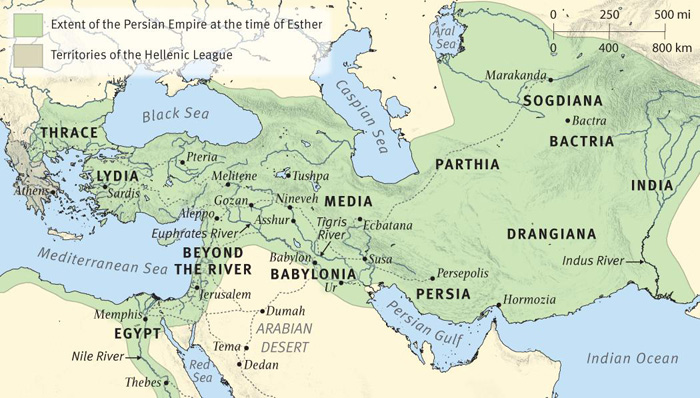This is what happened during the time of Xerxes, the Xerxes who ruled over 127 provinces stretching from India to Cush: At that time King Xerxes reigned from his royal throne in the citadel of Susa, and in the third year of his reign he gave a banquet for all his nobles and officials. The military leaders of Persia and Media, the princes, and the nobles of the provinces were present.
For a full 180 days he displayed the vast wealth of his kingdom and the splendor and glory of his majesty. When these days were over, the king gave a banquet, lasting seven days, in the enclosed garden of the king’s palace, for all the people from the least to the greatest who were in the citadel of Susa. The garden had hangings of white and blue linen, fastened with cords of white linen and purple material to silver rings on marble pillars. There were couches of gold and silver on a mosaic pavement of porphyry, marble, mother-of-pearl and other costly stones. Wine was served in goblets of gold, each one different from the other, and the royal wine was abundant, in keeping with the king’s liberality.
By the king’s command each guest was allowed to drink with no restrictions, for the king instructed all the wine stewards to serve each man what he wished.
As we begin our study of the book of Esther, I think some background here is helpful. The book records events that likely happened sometime between 483 B.C. and 473 B.C. This story takes place during the historical period after the Babylonian exile. Persia was the ruling power, with Susa being the capital of the Persian empire.
Some of the Jews were allowed to return to Jerusalem, where they had significant autonomy to run their own lives. Other Jews, including Mordecai and Esther, stayed in Susa, and were still living in exile. As a minority group in the Persian empire, the Jews were looked at with suspicion and faced threats of attacks, at times.
The 127 provinces that Xerxes I, the King, reigned over are shown in the attached map. This was a very large kingdom. Virtually all the Jews lived within its boundaries.
The Persian King liked to “wear his wealth” so to speak, and he also showed off from time to time. Some people drive fancy cars or wear fancy rings to show off their wealth, but for King Xerxes I to truly show off his fortune, it took 180 days straight. Finally, after these days ended (I’m sure the people were thinking, ”Thank God”), the King gave a seven-day banquet for his noble friends. He allowed them to drink as much wine as they desired. In all likelihood, this party would have turned into a drunken celebration in short order.
The king had lots of advisors around him, with some being elevated to a higher level. It is important to understand how decisions were made and the culture of this time. It was a pagan culture, with lots of immorality and all the vices that go with sin.
We live in a culture in the US that is quickly changing to embrace some of the types of things found in these Godless countries. So Esther is a particularly important book to study these days. Some initial questions to reflect on:
- How would I respond if my rights were taken away by the government?
- How should I live in an increasingly pagan country?
- What can I learn from Esther that will give me guidance and encourage me in these current days?
Lord, thank you for the book of Esther and its clear applicability for today. Open the eyes of my heart to see the truths I can glean from it.



I’m looking forward to your study on this book of Esther, Joe. So relevant for today.